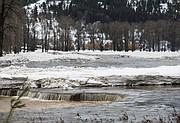The Joe lets loose
By BRIAN WALKER
Staff Writer
CALDER — Keith Sibert watched the St. Joe River roar across Elk Prairie Road on Friday.
"It hasn't been this bad for probably 10 years," said Sibert, who grew up in Calder and lives in St. Maries. "The flooding on this river can come on fast."
Temperatures that reached nearly 50 degrees broke up ice on the upper Joe, creating dams and causing lowland flooding. School was closed Friday.
The damage included a man's truck and RV west of Calder that became partially
submerged. The owner was shoveling on his property Friday to divert the water, and a small loader was brought in to help.
Residents in the town of Calder east of St. Maries in Shoshone County were also threatened by the river flowing over Elk Prairie Road just outside town. The road is the main access into the town. However, homes in the community were spared from the water.
Since Elk Prairie Road was closed, motorists could reach Calder only by driving about 10 miles up the Joe, crossing at Marble Creek, then heading back down the river.
In some areas, large ice chunks wound up on the banks of the river.
Sibert said he saw Mother Nature's wrath as a positive compared to other types of flooding.
"It's nice to get the ice out before the spring runoff," he said. "This flushing out of the river is actually a good thing."
St. Maries' Tony and Sherry Rothauge were among many residents who drove up the Joe to check out the flooding and ice dams. They had lunch at the Big Eddy Resort overlooking the roaring river.
"It's a yearly outing just to go see what's happening up the river," Sherry said with a smile.
Benewah County Sheriff Dave Resser and Office of Emergency Management Director Michelle Becktel spent the day monitoring the river. Resser said the ice dams were in three locations — near Calder, the Big Eddy Resort and Falls Creek.
"The big one's at Calder — that's historical," he said, referring to the common spot for ice dams.
Sibert remembers years ago when his father, Richard, a county foreman, used to take residents across the flooded road at Calder in a loader or military surplus boat.
"He used to haul kids across so they could get to the school bus," Sibert said. "You wouldn't dare do that today because I'm sure someone would sue you."
Richard Marlowe recalls one year about 25 years ago when the power was out in Calder for two weeks and a helicopter was used to bring in supplies.
While the river was flowing fast with ice chunks around Calder on Friday, it's still frozen over at St. Maries.
"It's been quite a few years since we've seen this much ice," said Steve Dittman, who lives in St. Joe City.
Resser said the flooding situation subsided in the afternoon.
"The ice jams are breaking up and the river is cleaning itself out," he said while having lunch at the Big Eddy. "If it continues the way it has been, we'll be in good shape. The river is starting to flush out without too much trouble."
Jim Shubert, a retired fire chief who helped battle flooding in Benewah County in 1996, said the St. Joe River valley still isn't out of the woods from major flooding, however.
"We've never had this much ice before at St. Maries, so there's still concerns," he said. "We're concerned about the high water flow coming down and meeting with the ice."
North Idaho Maritime has contracted with Benewah County to drive its tugboat up the St. Joe River to break up the ice to help stave off flooding, but Shubert said that can be a race against time because the break-up process up the Joe to reach St. Maries can take several days.
"The question becomes how fast," Shubert said.
Steve and Monica Nemeth said lowland flooding on the upper Joe occurs every few years.
"It just reminds us that it's not a good idea to live on the river," Monica said with a laugh. "We lease river lots near St. Maries, and I'm surprised we're not getting calls."
Steve said the recent mild winters were just enough to catch some residents off-guard when it comes to flooding on the Joe.
"Nobody should leave their property on the river this time of year and especially with this much snow," he said. "It can flood two or three times a year."
Dittman said the ice dams are generally just the first phase of flooding.
"When we get 50-degree weather, rain and winds, watch out because everything is going to go," he said.
Cheryl Brown said the flooding threat is as bad as it has been in the five years she has lived upstream from Calder.
"It's kind of scary," she said while watching the river flow over Elk Prairie Road. "I wouldn't want a place down low."
St. Maries' Nick Bond saw a silver lining with the flooding and harsh winter.
"Maybe this will help keep the wildfires down this summer," he said.















